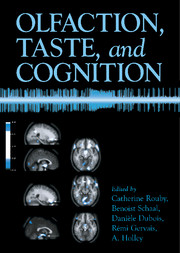Book contents
- Frontmatter
- Contents
- Contributors
- Preface
- Acknowledgments
- A Tribute to Edmond Roudnitska
- OLFACTION, TASTE, AND COGNITION
- Section 1 A Specific Type of Cognition
- Section 2 Knowledge and Languages
- Section 3 Emotion
- Section 4 Memory
- Section 5 Neural Bases
- Section 6 Individual Variations
- 24 New Psychophysical Insights in Evaluating Genetic Variation in Taste
- 25 The Individuality of Odor Perception
- 26 Olfactory Cognition at the Start of Life: The Perinatal Shaping of Selective Odor Responsiveness
- 27 Age-related Changes in Chemosensory Functions
- Index
- References
25 - The Individuality of Odor Perception
Published online by Cambridge University Press: 21 September 2009
- Frontmatter
- Contents
- Contributors
- Preface
- Acknowledgments
- A Tribute to Edmond Roudnitska
- OLFACTION, TASTE, AND COGNITION
- Section 1 A Specific Type of Cognition
- Section 2 Knowledge and Languages
- Section 3 Emotion
- Section 4 Memory
- Section 5 Neural Bases
- Section 6 Individual Variations
- 24 New Psychophysical Insights in Evaluating Genetic Variation in Taste
- 25 The Individuality of Odor Perception
- 26 Olfactory Cognition at the Start of Life: The Perinatal Shaping of Selective Odor Responsiveness
- 27 Age-related Changes in Chemosensory Functions
- Index
- References
Summary
Odors Are Cognitive Constructs
The central argument of this chapter is that odors are the products of plastic nervous systems and that to adequately understand how olfactory stimuli influence physiology and behavior it is necessary to understand how experience shapes the way odorants are received and processed. Fundamental to the argument is the conceptual distinction between odorants and odors (Hudson, 1999). Odorants are molecules, entities of the external world objectively definable in terms of physicochemical characteristics and capable of being interpreted by particular nervous systems to yield the perceptions we call odors. Odors are the subjective products – constructs, if you like – of individual nervous systems and thus potentially are open to the many modulating influences of what might broadly be thought of as “mind.” They are among the phenomena that drive behavioral, physiological, and psychological functioning and thus are phenomena that we need to understand.
Following from that, we shall not be able to provide a proper account of olfactory function without considering the role of individual experience in shaping it. Indeed, increasing numbers of studies are suggesting that learning significantly influences aspects of olfactory function as diverse as the evocation of memories and associations, hedonic judgment, the early acquisition of preferences, and the ability to perceive and discriminate odors (Engen, 1991), as reviewed by Ayabe-Kanamura et al. (1998); see also the chapters in Sections 2 and 3 of this volume.
- Type
- Chapter
- Information
- Olfaction, Taste, and Cognition , pp. 408 - 420Publisher: Cambridge University PressPrint publication year: 2002
References
- 17
- Cited by

